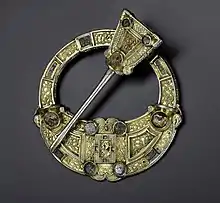Irish gold
Irish gold is gold that occurs naturally in areas of Ireland. Ireland was the major area of gold working in the Bronze Age British Isles. Irish gold is especially well known from the Irish Bronze Age as jewellery, in the form of gold lunulae, torcs, gorgets and rings.[2]




History
The first gold was produced in Ireland c. 2500 BC during the late Neolithic/Atlantic Bronze Age. Sun discs and lunulae were produced from hammered gold. Lead-isotope and major-element analyses have shown this gold to mostly be from Cornwall, also a major ancient source of tin. In return, Irish copper was exchanged for this foreign gold.[3][4] Around 1200 BC torcs began to be produced using new techniques. From 900 BC bracelets, dress-fasteners, sheet gold collars and ear-spools were made in Ireland.[5]
Occurrence

A likely source for Irish gold is placer mining in Ireland's rivers, including the rivers of County Wicklow and the "Gold Coast" of County Waterford.[6][7] Other likely ancient sources based on placenames include Slieveanore ("Gold Mountain", County Clare), Tullynore ("Gold Hillock", County Down), Coomanore ("Gold Hollow", County Cork), Luganore ("Gold Hollow", County Tipperary) and Glenanore ("Gold Valley", County Cork).[8][9] Note that the Golden Vale is not named for the metal, but for its high quality soil; the town of Golden, County Tipperary takes its name from the Irish gabhailín, "river fork"; and Shanagolden, County Limerick is from seanghualainn, "old shoulder".[10][11][12]
All gold in the ground in the Republic of Ireland is the property of the state. Recreational gold panning is permitted, but the gold cannot be sold and finds of over 20 flakes or 2 grams (0.064 ozt) must be reported.[13]
Between 1796 and 1860 about 300 kilograms (9,600 ozt) of gold was mined in Ireland, from places including the Gold Mines River, County Wicklow.[14]
In 2008 a major discovery was announced near Clontibret, estimated at 500,000 troy ounces (16,000 kg). The mining is run by Conroy Gold and Natural Resources and Anglo Asian Mining.[15] Total resources could be as high as 20,000,000 troy ounces (620 t).[16][13][17]
References
- "A brief history of the gold hidden around Ireland". TheJournal.ie. 9 September 2013.
- "#79 - Gold - Au".
- "Archaeologists discover evidence of prehistoric gold trade route between Britain and Ireland | Irish Archaeology". irisharchaeology.ie. June 5, 2015.
- "Bronze Age Ireland's Taste in Gold - Archaeology Magazine". www.archaeology.org.
- "Ór - Ireland's Gold | Archaeology". National Museum of Ireland.
- "Looking for gold in Ireland? Here's where to find it". IrishCentral.com. March 26, 2018.
- "Introduction to the Gold Collection". National Museum of Ireland.
- Beresford, Jack. "Do you live near one of Ireland's hidden gold hotspots?". The Irish Post.
- "Recreational Gold Panning in Ireland - Frequently Asked Questions" (PDF). www.mineralsireland.ie. September 2014. Retrieved 15 January 2022.
- Room, Adrian (September 26, 2006). Nicknames of Places: Origins and Meanings of the Alternate and Secondary Names, Sobriquets, Titles, Epithets and Slogans for 4600 Places Worldwide. McFarland & Company. ISBN 9780786424979 – via Google Books.
- "An Gabhailín/Golden". Logainm.ie.
- "Seanghualainn/Shanagolden". Logainm.ie.
- "Four new gold mines discovered in Ireland". independent. 18 July 2016.
- "Mining in Ireland". www.mineralsireland.ie.
- "Ireland's first modern commercial gold mine could be open by 2023". Extra.ie. July 26, 2020.
- "Mining in Ireland". Conroy Gold and Natural Resources. April 29, 2013.
- "Ireland seen as 'significant' new gold mining region". Irish Examiner. March 27, 2018.